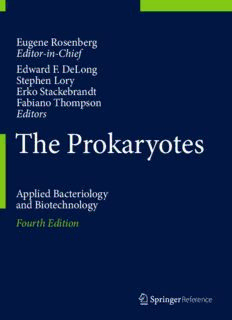
The Prokaryotes: Applied Bacteriology and Biotechnology PDF
Preview The Prokaryotes: Applied Bacteriology and Biotechnology
ESR dto a scs .ke n e bb Eugene Rosenberg re ar ng Editor-in-Chief d· tD · Edward F. DeLong e T L ho Stephen Lory on m g Erko Stackebrandt p· sL Fabiano Thompson o o n r Editors y The Prokaryotes 1 aAT n p d ph Bl iiee Applied Bacteriology od t eB c P and Biotechnology a h c ntr oero loio glk Fourth Edition yo ga y r y o t e s Life Sciences isbn 978-3-642-31330-1 1 3 9 783642 313301 4th Ed. Reference The Prokaryotes Eugene Rosenberg (Editor-in-Chief) Edward F. DeLong, Stephen Lory, Erko Stackebrandt and Fabiano Thompson (Eds.) The Prokaryotes Applied Bacteriology and Biotechnology Fourth Edition With132Figuresand63Tables Editor-in-Chief EugeneRosenberg DepartmentofMolecularMicrobiologyandBiotechnology TelAvivUniversity TelAviv,Israel Editors EdwardF.DeLong FabianoThompson DepartmentofBiologicalEngineering LaboratoryofMicrobiology,InstituteofBiology,Centerfor MassachusettsInstituteofTechnology HealthSciences Cambridge,MA,USA FederalUniversityofRiodeJaneiro(UFRJ) IlhadoFunda˜o,RiodeJaneiro,Brazil StephenLory DepartmentofMicrobiologyandImmunology HarvardMedicalSchool Boston,MA,USA ErkoStackebrandt LeibnizInstituteDSMZ-GermanCollectionofMicroorganisms andCellCultures Braunschweig,Germany ISBN978-3-642-31330-1 ISBN978-3-642-31331-8(eBook) ISBN978-3-642-31332-5(printandelectronicbundle) DOI10.1007/978-3-642-31331-8 SpringerHeidelbergNewYorkDordrechtLondon LibraryofCongressControlNumber:2012955035 3rdedition:©SpringerScience+BusinessMedia,LLC2006 4thedition:©Springer-VerlagBerlinHeidelberg2013 Thisworkissubjecttocopyright.AllrightsarereservedbythePublisher,whetherthewholeorpartofthematerialisconcerned,specificallytherightsof translation, reprinting, reuse of illustrations, recitation, broadcasting, reproduction on microfilms or in any other physical way, and transmission or informationstorageandretrieval,electronicadaptation,computersoftware,orbysimilarordissimilarmethodologynowknownorhereafterdeveloped. Exemptedfromthislegalreservationarebriefexcerptsinconnectionwithreviewsorscholarlyanalysisormaterialsuppliedspecificallyforthepurposeof beingenteredandexecutedonacomputersystem,forexclusiveusebythepurchaserofthework.Duplicationofthispublicationorpartsthereofispermitted onlyundertheprovisionsoftheCopyrightLawofthePublisher’slocation,initscurrentversion,andpermissionforusemustalwaysbeobtainedfrom Springer.PermissionsforusemaybeobtainedthroughRightsLinkattheCopyrightClearanceCenter.Violationsareliabletoprosecutionundertherespective CopyrightLaw. Theuseofgeneraldescriptivenames,registerednames,trademarks,servicemarks,etc.inthispublicationdoesnotimply,evenintheabsenceofaspecific statement,thatsuchnamesareexemptfromtherelevantprotectivelawsandregulationsandthereforefreeforgeneraluse. Whiletheadviceandinformationinthisbookarebelievedtobetrueandaccurateatthedateofpublication,neithertheauthorsnortheeditorsnorthepublisher canacceptanylegalresponsibilityforanyerrorsoromissionsthatmaybemade.Thepublishermakesnowarranty,expressorimplied,withrespecttothe materialcontainedherein. Printedonacid-freepaper SpringerispartofSpringerScienceþBusinessMedia(www.springer.com) Foreword Thepurposeofthisbriefforewordisunchangedfromthefirstedition;itissimplytomakeyou,thereader,hungryforthescientific feastthatfollows.These11volumes(planned)ontheprokaryotesofferanexpandedscientificmenuthatdisplaysthebiochemical depthandremarkablephysiologicalandmorphologicaldiversityofprokaryotelife.Thesizeofthevolumesmightinitiallydiscourage theunpreparedmindfrombeingattractedtothestudyofprokaryotelife,forthislandmarkassemblagethoroughlydocumentsthe wealthofpresentknowledge.Butinconfrontingthereaderwiththestateoftheart,theHandbookalsodefineswheremorework needstobedoneonwell-studiedbacteriaaswellasonunusualorpoorlystudiedorganisms. This edition of The Prokaryotes recognizes the almost unbelievable impact that the work of Carl Woese has had in defining aphylogeneticbasisforthemicrobialworld.Theconceptthattheribosomeisahighlyconservedstructureinallcellsandthatits nucleicacidcomponentsmayserveasaconvenientreferencepointforrelatingalllivingthingsisnowgenerallyaccepted.Atlast,the phylogenyofprokaryoteshasascientificbasis,andthisisthefirstseriousattempttopresentacomprehensivetreatiseonprokaryotes along recently defined phylogenetic lines. Although evidence is incomplete for many microbial groups, these volumes make astatementthatclearlyilluminatesthepathtofollow. Therearebasicallytwowaysofdoingresearchwithmicrobes.Aclassicalapproachisfirsttodefinethephenomenontobestudied andthentoselecttheorganismaccordingly.Anotherwayistochooseaspecificorganismandgowhereitleads.Thepursuitofan unusualmicrobebringsoutthelatenthunterinallofus.Theintellectualchallengesofthechasefrequentlytestouringenuitytothe limit.Sometimesthequarryrepeatedlyescapes,butthefinalcaptureisindeedawonderfulexperience.Formanyofus,thesesimple rewards are sufficiently gratifying so that we have chosen to spend our scientific lives studying these unusual creatures. In these endeavors,manyofthestrategiesandtoolsaswellasmuchofthephilosophymaybetracedtotheDelftSchool,passedontousbyour teachers,MartinusBeijerinck,A.J.Kluyver,andC.B.vanNiel,andinturnpassedonbyustoourstudents. Inthisschool,theprinciplesoftheselective,enrichmentculturetechniquehavebeendevelopedanddiversified;theyhavebeen amajorforceindesigningandapplyingnewprinciplesforthecaptureandisolationofmicrobesfromnature.Forme,the‘‘organism approach’’hasprovidedrewardingadventures.Theorganismcontinuallychallengesandliterallydragstheinvestigatorintonewareas whereunfamiliar toolsmaybeneeded.Ibelievethatorganism-orientedresearchisanimportantalternativetoproblem-oriented research,fornewconceptsofthefutureverylikelylieinastudyofthebreadthofmicrobiallife.Thephysiology,biochemistry,and ecology of the microbe remain the most powerful attractions. Studies based on classical methods as well as modern genetic techniqueswillresultinnewinsightsandconcepts. Tosomereaders,thiseditionofTheProkaryotesmayindicatethatthefieldisnowmature,thatfromhereonitisamatteroffilling indetails.Isuspectthatthisisnotthecase.Perhapswehaveassumedprematurelythatwefullyunderstandmicrobiallife.VanNiel pointedouttohisstudentsthat—afteralifetimeofstudy—itwasaveryhumblingexperiencetoviewinthemicroscopeasampleof microbesfromnatureandrecognizeonlyafew.Recentevidencesuggeststhatmicrobeshavebeenevolvingfornearly4billionyears. Mostcertainly,thosemicrobesnowdomesticatedandkeptincaptivityinculturecollectionsrepresentonlyaminorportionofthe speciesthathaveevolvedinthistimespan.Sometimeswemustremindourselvesthatevolutionisactivelytakingplaceatthepresent moment.Thattheeukaryotecellevolvedasachimeraofcertainprokaryotepartsisagenerallyacceptedconcepttoday.Higheraswell aslowereukaryotesevolvedincontactwithprokaryotes,andevidencesurroundsusofthecomplexinteractionsbetweeneukaryotes andprokaryotesaswellasamong prokaryotes.Wehavesofaronlyscratchedthesurfaceofthesebiochemicalinterrelationships. Perhapsthelegumenoduleisapertinentexampleofnaturecaughtintheactofevolvingthe‘‘nitrosome,’’auniquenitrogen-fixing organelle.Thestudyofprokaryotesisproceedingatsuchafastpacethatmajoradvancesareoccurringyearly.Theincreaseofthis editiontofourvolumesdocumentstheexcitingpaceofdiscoveries. ToprepareatreatisesuchasTheProkaryotesrequiresdedicatededitorsandauthors;thetaskhasbeenenormous.Ipredictthatthe scientificcommunityof microbiologists will again showits appreciation through use of these volumes—such that thepages will become‘‘dog-eared’’andwornasstudentsseekbasicinformationforthehunt.Thesevolumesbelonginthelaboratory,notinthe library.Ibelievethatamosteffectivewaytointroducestudentstomicrobiologyisforthemtoisolatemicrobesfromnature,thatis, from their habitats in soil, water, clinical specimens, or plants. The Prokaryotes enormously simplifies this process and should encourage the construction of courses that contain a wide spectrum of diverse topics. For the student as well as the advanced investigator,thesevolumesshouldgenerateexcitement. Happyhunting! RalphS.Wolfe DepartmentofMicrobiology UniversityofIllinoisatUrbana-Champaign Preface Duringmostofthetwentiethcentury,microbiologistsstudiedpureculturesunderdefinedlaboratoryconditionsinordertouncover the causative agents of disease and subsequently as ideal model systems to discover the fundamental principles of genetics and biochemistry. Microbiology as a discipline onto itself, e.g., microbial ecology, diversity, and evolution-based taxonomy, has only recentlybeenthesubjectofgeneralinterest,partlybecauseoftherealizationthatmicroorganismsplayakeyroleintheenvironment. Thedevelopmentandapplicationofpowerfulculture-independentmolecular techniquesandbioinformaticstoolshasmadethis developmentpossible.ThefourtheditionoftheHandbookoftheProkaryoteshasbeenupdatedandexpandedinordertoreflectthis neweraofmicrobiology. Thefirstfivevolumesofthefourtheditioncontain34updatedand43entirelynewchapters.Mostofthenewchaptersareinthe twonewsections:ProkaryoticCommunitiesandBacteriainHumanHealthandDisease.Acollectionofmicroorganismsoccupying thesamephysicalhabitatiscalleda‘‘community,’’andseveralexamplesofbacterialcommunitiesarepresentedintheProkaryotic Communities section, organized by Edward F. DeLong. Over the last decade, important advances in molecular biology and bioinformaticshaveledtothedevelopmentofinnovativeculture-independentapproachesfordescribingmicrobialcommunities. Thesenewstrategies,basedontheanalysisofDNAdirectlyextractedfromenvironmentalsamples,circumventthestepsofisolation andculturingofmicroorganisms,whichareknownfortheirselectivityleadingtoanonrepresentativeviewofprokaryoticdiversity. Describingbacterialcommunitiesisthefirststepinunderstandingthecomplex,interactingmicrobialsystemsinthenaturalworld. ThesectiononBacteriainHumanHealthandDisease,organizedbyStephenLory,containschaptersonmostoftheimportant bacterialdiseases,eachwrittenbyanexpertinthefield.Inaddition,thereareseparategeneralchaptersonidentificationofpathogens byclassicalandnon-culturingmoleculartechniquesandvirulencemechanisms,suchasadhesionandbacterialtoxins.Inrecognition of the recent important research on beneficial bacteria in human health, the section also includes chapters on gut microbiota, prebiotics,andprobiotics.TogetherwiththeupdatedandexpandedchapteronBacterialPharmaceuticalProducts,thissectionis avaluableresourcetograduatestudents,teachers,andresearchersinterestedinmedicalmicrobiology. Volumes 6–11, organized by Erko Stackebrandt and Fabiano Thompson, contain chapters on each of the ca. 300 known prokaryoticfamilies.Eachchapterpresentsboththehistoricalandcurrenttaxonomyofhighertaxa,mostlyabovethegenuslevel; molecular analyses (e.g., DDH, MLSA, riboprinting, and MALDI-TOF); genomic and phenetic properties of the taxa covered; genome analyses including nonchromosomal genetic elements; phenotypic analyses; methods for the enrichment, isolation, and maintenanceofmembersofthefamily;ecologicalstudies;clinicalrelevance;andapplications. Asinthethirdedition,thevolumesinthefourtheditionareavailablebothashardcopiesande-books,andaseReferences.The advantagesoftheonlineversionincludenorestrictionofcolorillustrations,thepossibilityofupdatingchapterscontinuouslyand, mostimportantly,librariescanplacetheirsubscribedcopiesontheirservers,makingitavailabletotheircommunityinofficesand laboratories.TheeditorsthankallthechapterauthorsandtheeditorialstaffofSpringer,especiallyHannaHensler-Fritton,Isabel Ullmann,DanielQuin˜ones,AlejandraKudo,andAudreyWong,formakingthiscontributionpossible. EugeneRosenberg Editor-in-Chief About the Editors EugeneRosenberg(Editor-in-Chief) DepartmentofMolecularMicrobiologyandBiotechnology TelAvivUniversity TelAviv Israel EugeneRosenbergholdsaPh.D.inbiochemistryfromColumbiaUniversity(1961)wherehedescribedthechemicalstructuresofthe capsules of Hemophilus influenzae, types B, E, and F. His postdoctoral research was performed in organic chemistry under the guidanceofLordToddinCambridgeUniversity.HewasanassistantandassociateprofessorofmicrobiologyattheUniversityof CaliforniaatLosAngelesfrom1962to1970,whereheworkedonthebiochemistryofMyxococcusxanthus.Since1970,hehasbeenin the Department of Molecular Microbiology and Biotechnology, Tel Aviv University, as an associate professor (1970–1974), full professor(1975–2005),andprofessoremeritus(2006–present).HehasheldtheGolChairinAppliedandEnvironmentalMicro- biologysince1989.HeisamemberoftheAmericanAcademyofMicrobiologyandEuropeanAcademyofMicrobiology.Hehasbeen awarded a Guggenheim Fellowship, a Fogarty International Scholar of the NIH, the Pan Lab Prize of the Society of Industrial Microbiology,theProctor&GamblePrizeoftheASM,theSakovPrize,theLandauPrize,andtheIsraelPrizefora‘‘BeautifulIsrael.’’ Hisresearchhasfocusedonmyxobacteriology;hydrocarbonmicrobiology;surface-activepolymersfromAcinetobacter;biore- mediation;coralmicrobiology;andtheroleofsymbioticmicroorganismsintheadaptation,development,behavior,andevolutionof animalsandplants.Heistheauthorofabout250researchpapersandreviews,9books,and16patents.
Description: